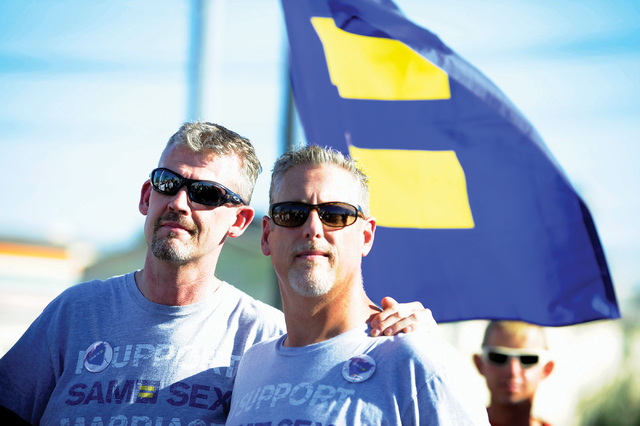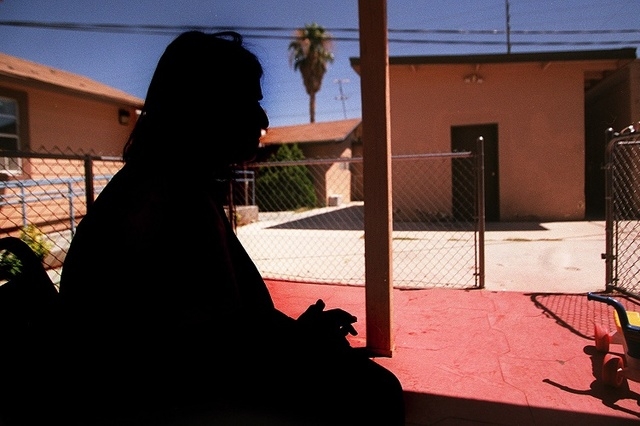Gay marriage could help domestic violence programs
Gay marriage activists in Nevada have an unlikely fiscal ally: domestic violence programs.
That’s because the only state-allocated source of domestic violence program funding comes from a $25 surcharge on each Nevada-issued marriage license. Revenue from that surcharge has dropped over the past decade as marriage rates have fallen throughout the United States and fewer tourists have headed to Las Vegas to elope.
But making it legal for same-sex couples to wed in Nevada would mean an increase in marriage license revenue, observers say, and a windfall for domestic outreach programs such as Safe Nest, the state’s largest domestic violence charity.
“We understand this is a controversial issue,” said Estelle Murphy, executive director of Safe Nest. “We are neutral in terms of taking a stand on it, however we recognize the reality that if there were gay marriage in Nevada that we would be assisted substantially by the increase in funds.”
Last fiscal year, the state collected and allocated less than $3 million total for programs like the Nevada Network Against Domestic Violence and Safe Nest shelters through marriage license surcharges, according to Clark County spokesman Dan Kulin. That figure also includes a $5 surcharge Clark County assesses for each civil marriage service.
Domestic violence programs also receive grants from other sources, but the marriage license surcharge is the most consistent source of money. Despite a surcharge increase about four years ago that boosted state funding to nearly $3.5 million, funding totals are nearly equivalent to 2003 levels at $2.7 million and dropping, said Sue Meuschke, executive director of the Nevada Network Against Domestic Violence.
“Historically Nevada has had a higher per capita marriage rate than every other state,” Meuschke said, but between 1950 and 2011 marriage rates declined by about 66 percent, according to a University of Maryland study. “There’s an overall decline in marriage around the country, and during the recession there was a decline in people traveling to Nevada to get married.”
Besides the drop in marriage licenses, last year’s census data recognized Nevada for receiving one of the greatest cuts in government funding for domestic violence programs in the nation. In a survey, 50 percent of Nevadans who were refused assistance for domestic violence were turned away because of a lack of funding. The only state that turned away victims at a higher rate due to budget cuts was New Mexico at 52 percent.
“Last year when sequestration kicked in there was an across-the-board cut, and that had a huge impact,” Meuschke said.
That, combined with a decrease from marriage licenses, hit the Nevada domestic violence outreach community hard.
“It’s that perfect storm you talk about,” Meuschke said. “Suddenly you’ve cut everything you can possibly cut, and now you’re starting to close things.”
A STATE OF CRISIS
As funds dry up for valley outreach programs, the state of domestic violence in Nevada remains one of the worst in the country.
About 48.2 percent of women living in Nevada have experienced some form of domestic violence in their lifetime, according to Lisa Lynn Chapman of Safe Nest. Chapman acknowledged that not all perpetrators are men, but being a woman in Nevada carries its statistical risks.
Throughout the past 15 years of available Violence Policy Center data, Nevada ranked in the top 10 for men murdering women, and 90 percent of those cases, on average, were domestic violence-related homicides. For six of those years Nevada ranked No. 1, including 2008, 2009 and 2010.
The Violence Policy Center, a nonprofit that conducts research on violence in America, releases reports with a two-year delay, so data for 2012 and 2013 is not available yet.
The only year Nevada didn’t place in the top 10, according to available data, was 2011, but Meuschke said these totals are ranked per capita. Judging by population, Nevada comes in at No. 35 of 50 at a little under 3 million people, so “a small difference can be significant,” she said.
Twenty women were murdered by men in Nevada in 2011 — 15 less than in 2010, a year in which Nevada ranked No. 1. Though Meuschke said she was “cautiously optimistic” about the drop, the Metropolitan Police Department reported that 25 domestic violence-related homicides happened in Clark County alone in 2012 and 30 in 2013. The victims’ gender were not specified.
As of mid-June this year, Metro reports 15 domestic violence victims have been killed.
The Nevada attorney general’s office recognized the crisis and created a combined Domestic Violence Fatality Review task force in 2011 to address the issue.
The task force consists of a team in Washoe County and Clark County, as well as a statewide team that serves rural areas.
“Instead of just scratching the surface, we’re digging much deeper,” said Washoe County Assistant Sheriff Darin Balaam, describing detectives delving into case history and making more in-depth and well-researched recommendations.
These recommendations are typically systemic changes aimed at preventing deaths, said Tara Phebus, the Clark County team’s coordinator. Examples include youth domestic violence education, eliminating language barriers in community domestic violence resources, and recommending legislative change, but it’s on a case-by-case basis, she said.
“The end goal is to prevent fatalities due to domestic violence,” Phebus said. “To have zero deaths related to domestic violence in our community.”
But despite investigative efforts, no change in Clark County has been implemented.
Attorney general’s office spokeswoman Jennifer Lopez said task force recommendations are long-term, adding that they require complicated collaboration from multiple stakeholders including judges and law enforcement.
“If you consider domestic violence a pie, the domestic violence fatality review is a piece of that,” Lopez said. “Everyone comes to the table caring about domestic violence and wanting to solve the issue, but they have different pieces that are important to them. (The recommendations) certainly can’t happen overnight as much as we’d like them to, but they’re certainly being addressed.”
Mueschke said even though tangible systemic change hasn’t come about since the combined review team has been working, creating the task force was a step in the right direction.
“The mere fact of bringing people together to talk about this issue makes people aware of the link between homicide and domestic violence,” Meuschke said. “That’s one piece of the puzzle.”
INVESTIGATING CASES
Valley outreach programs are not the only resources that are spread thin. As domestic violence funding continues to drop, detectives who dedicate their work to helping victims said casework is piling up and courtrooms are crowded.
An average of 21,000 domestic disturbance calls are placed in Clark County each year, Detective Robert Schmidt said. The domestic violence unit operates with two squads and 15 detectives, which means each detective oversees about 120 cases a month.
Out of all the calls handled by detectives, Schmidt said about 19,000 choose to file police reports and only about 10,000 cases are sent to court, either by an arresting officer or a detective.
But that leaves the valley’s only domestic violence court swimming in about 10,000 cases to sort through each year, and for many victims, justice is a far reach.
Chapman said outreach programs like Safe Nest can help victims create support systems and access case management resources, which increase the likelihood of conviction and decrease the chance of someone becoming a victim again. But with less funding, there are fewer resources.
“It’s very crucial,” Chapman said. “Going through the court system for the best of us is a very difficult thing. When you’ve dealt with the upheaval of having your loved one harm you, and then now you’re a witness against someone who you have loved? That’s a huge retraumatization.”
Typical domestic violence cases can take about a month to process, and felony cases can take about nine to 12 months after the initial incident. By then victims often lose their fire, Schmidt said. They’ve repeated their story to multiple officers, judges and attorneys, and they get burned out. Family is on their mind — the good of the children, the income an accuser may bring into the household — and without a solid support system, victims often end up refusing to pursue the case.
“The wheels of justice move very slowly,” Schmidt said. “With one domestic violence court, it’s almost impossible to get through this. We could probably use one or even two more domestic violence courtrooms to put a dent in it. They’re doing the best they can.”
The most important thing a victim can do is report an incident and report it quickly in order to ensure evidence and expedite the legislative process, Schmidt said. Without a visible injury or a witness, it’s hard to close a case.
LOOKING AHEAD
Despite salary freezes and therapy cutbacks, Chapman encouraged victims to contact Safe Nest through its 24-hour crisis hotline at 702-646-4981.
From there, they can receive information on shelter stay, protection orders, crisis counseling and perpetrator counseling. A list of all county resources for domestic violence victims can be found at clarkcountynv.gov including family services agencies and legal assistance.
“It’s been stressful,” Chapman said. “One of the things we’re proud of is that we are doing what’s necessary. All of our services are essential.”
Though the attorney general’s office cannot speculate how gay marriage laws would affect state programs, gay rights activists like Freedom Nevada Director Ward Curtin have recognized what legalization could mean for community programs.
“Just for in-state couples, we’re looking at $4 million more for state and local government,” Curtin said, though that’s a projected three-year, across-the-board increase that does not specify domestic violence programs.
Still, more marriage means more money.
“These figures only estimate local marriages,” he said. “It doesn’t at all take into account destination weddings.”
Contact Rachel Crosby at rcrosby@reviewjournal.com or 702-387-5290. Find her on Twitter: @rachelacrosby.





























